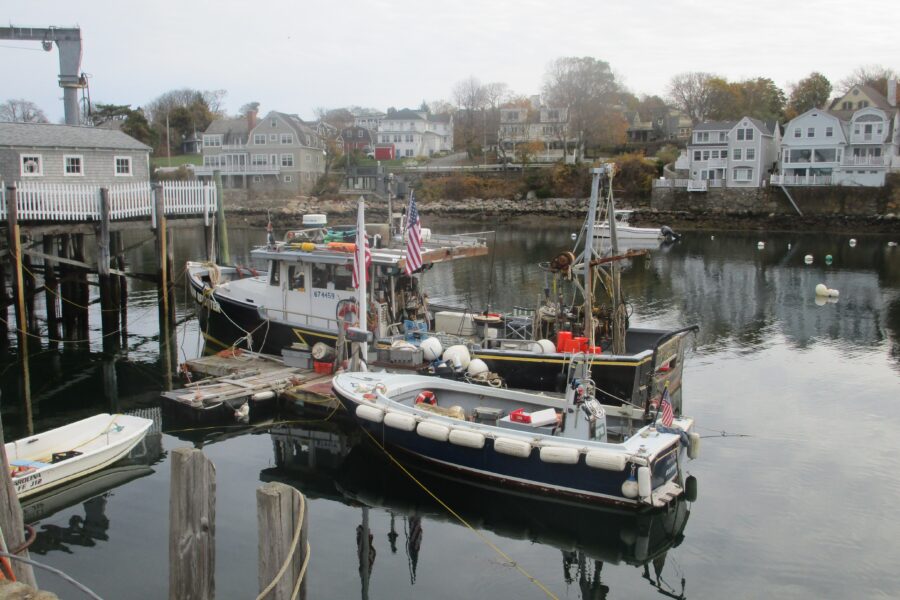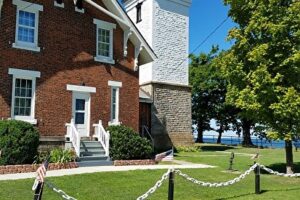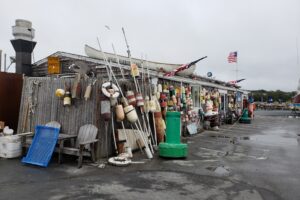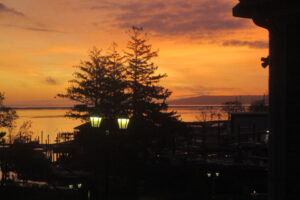Rockport
We tread carefully along the narrow walkway that edges the workingman’s harbor in Rockport. It is cold. Gloomy. Gray. Still as death. It is a perfect setting for a bleak monochromatic painting of a New England fishing village except for the faded red beacon that draws us forward—and everybody else that has heard about it. But not today.
We walk in virtual solitude.






An ancient mariner lumbers across the stone pier and begins his days work. The Amie leaves her berth. All other vessels stay put, either tethered to the dock or tied to their moorings.


In 1966, Michael and I stood where we now stand, and were charmed. We took one photograph. Maybe two. Photographs were on film and cost money to produce. And we were Army poor.

History of the Faded Red Beacon
Standing on a granite pier, and built in the mid-1840s, the little red beacon began as a humble fishing shack, housing supplies and daily catches of and for the fisherman of Rockport. Later it became a sailors meeting place when the U.S. Navy fleet docked in Rockport. In the 1930’s it renewed itself as an artist’s studio. Finally, its notoriety caused it to become a city-owned monument to the area’s veterans.
The little red fishing shack was destroyed by a blizzard in 1978. However since it had become such an integral part of Rockport’s identity, the town rebuilt an almost exact replica that stands before us today. I wouldn’t have known unless I was told. Michael says we still have the original ’66 picture. When we return home, we need to compare the structures.

A noted New England icon, the humble little fishing shack, with the unlikely name of Motif No.1 (that is another, longer story) happens to have the reputation of being the most painted building (by artists) in the world. We even have a pen & ink drawing of it in our library, that is based on our earlier photograph. It was rendered by an extremely talented artist friend of many years ago—known only as Sigi.
Highway 127
Today all is peaceful. Tranquil. A reason to linger. But we don’t. Instead we climb in our car and travel down scenic Highway 127 that circles the rocky Cape Ann peninsula and will eventually take us south of Rockport to the town of Gloucester, America’s oldest fishing port.
Leaving the environs of Rockport, Michael sees a sign for a granite pier. Without a word or a warning, he turns quickly toward the bay. This man has the eyes of an eagle and an innate sense of direction. He grabs his camera and exits the car, returning with a smile, and one more lighthouse photograph.

An Elusive Lighthouse

With no particular destination in mind, we nose in and out of byways where old weathered houses spaced too close together live their lives on twisted, narrow lanes.
Always in search of the elusive lighthouse, this one, called Annisquam at Wigwam Point on Ipswich Bay, looks promising. I see a photo on Google Maps, and it sits on land. But it too remains an intangible object. Unfortunately accessibility was always limited, but now the road is closed. PRIVATE, the sign says. Access to the beach adjacent to the 1897 light is denied us too. PRIVATE. Again.
I’m beginning to think we definitely need to write off Massachusetts as a lighthouse lovers haven. Even though it looks like they outline the entire 192 miles of the coast of this state.
Gloucester

With a current population over 30,000, Gloucester can no longer be classified as a village. It is crowded. But old and worn, just as the oldest fishing village in America should be. However, the pub where we stop to have a very late lunch looks shiny and new. Seating is picnic table style, a community free-for-all. Two women sit across from us, and I spend my time, while I wait for lunch, getting to know who what were and why they are here.
Friends. Symphonic cellist from Wisconsin. Wannabe cellist from Gloucester formerly Boston originally Maine. Visiting. Scientist husband in Boston needs to retire. Said husband claims this is his favorite restaurant. Both claiming to “normally” be vegetarians. One orders burnt ends barbeque. The other orders mussels. I like both ladies.
Michael apologizes for my inquisitiveness, but really, it is a two way street.
Discovering we are from Texas, I find that they think we eat nothing but beef and barbecue. Well, we do eat that, but I let them know our diet is varied and many different types of proteins are on our table at home—and at restaurants. As well as many vegetables. And wine. And that retirement is a good thing.





Remembering Fish & Chips
Our food arrives, and it is the best fish and chips we have had since we were in England two years ago. I must tell Ian, our very English friend, who loves fish and chips. But I fear it will make him homesick for Whitby’s shatteringly crisp fish, as he remembers munching away on their goodness while sitting on the quay with Norma on a cold gray day on the Yorkshire Coast. I think I’m having an attack of nostalgia myself. This day is very English–feeling.





We explore the areas around the harbor in Gloucster then decide since we are going to be in the middle of rush hour traffic leaving Boston, we need to be on our way.
Home Again
It takes us over three hours to traverse the short distance—80 miles—to arrive in Plymouth.
Returning home, Michael heads to the computer to see how many people actually live in this state in comparison to Texas. Well, Texas has a lot. We are the second largest in population at over 28 million people. Massachusetts has less than 7 million. But the rub comes in population per square mile, especially if you compare Boston to Austin (which seems very overly crowded to me). Boston has almost 13,000 individuals per square mile, while Austin—our nearest neighbor at home has only 2,600.
“This place has too many people,” is the sigh I hear at the opposite end of the table. I agree. We cross Monday’s planned trip to Salem, even closer to Boston, off our list.















Leave a Reply
Your email is safe with us.